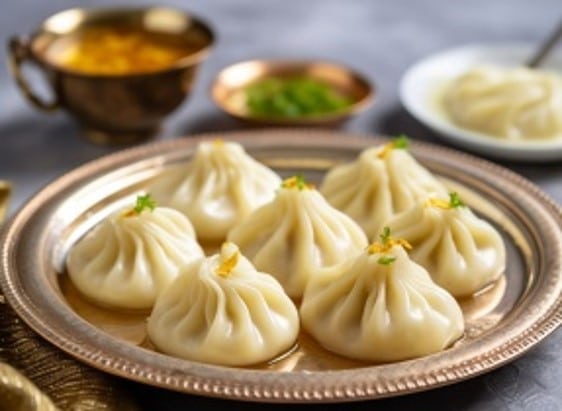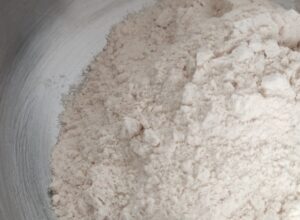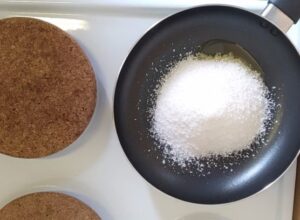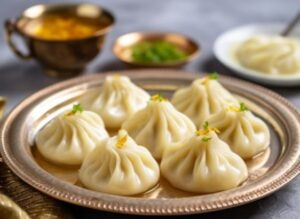Modak Recipe
When the sweet aroma of coconut and jaggery slowly infuses the air in my kitchen, I know it’s that time of year again – Ganesh Chaturthi. For someone who adores cooking and lives to critique food, preparing Modak Recipe is akin to a spiritual experience. As a housewife and an avid food blogger, the act of shaping these delectable dumplings feels like an intimate dance between my hands and the ingredients. Each Modak I make is a bundle of joy, a symphony of flavors that I can’t wait to share with family and friends. The soft texture, the harmonious blend of sweetness and nuttiness—it’s all a part of my annual culinary ritual.
What is Modak?
Modak is a dumpling made from rice or wheat flour, and its soul is a filling made from grated coconut, jaggery, and a pinch of cardamom or nutmeg. But to define it merely by its ingredients would be akin to calling a sonnet a bunch of words. The exterior is soft, almost melting in your mouth, giving way to a rich, textured filling that bursts with flavors of coconut, jaggery, and aromatic spices. It’s a gastronomic ode to the Indian tradition, encapsulating joy, devotion, and a rich culinary heritage in each bite.
Modak is not just a food item; it’s a cultural emblem, especially during Ganesh Chaturthi. Often referred to as “Ganesha’s favorite sweet,” this iconic dish has transcended generations and geographies.
Also See: Ganesh Chaturthi Recipes
Variations of Modak Recipe
Steamed Modak (Ukadiche Modak): This is the traditional form, often made during Ganesh Chaturthi. Made with rice flour, these Modaks are steamed to perfection, resulting in a soft, translucent exterior that’s irresistibly delicious.
Fried Modak: For those who love a bit of crunch, the fried Modak is an absolute delight. Made with a wheat flour shell, these are deep-fried until golden, offering a contrasting texture to the traditional steamed version.
Chocolate Modak: In a contemporary twist, these Modaks are a hit among the younger crowd. The traditional coconut and jaggery filling is replaced or complemented by chocolate, offering a fusion of flavors.
Dry Fruit Modak: Stuffed with a mixture of finely chopped dry fruits like almonds, cashews, and pistachios, this variation is not only delicious but also adds a healthful punch to the festive celebrations.
Nutrition – Modak recipe
High in Fiber: Thanks to the coconut filling, Modaks offer a reasonable amount of dietary fiber. While they may be a dessert, they can aid in digestion, which is especially helpful during festival seasons when heavy meals are the norm.
Nutrients from Jaggery: Jaggery, an unrefined sugar, contains numerous minerals and vitamins. It is often considered a healthier alternative to white sugar, offering a complex flavor profile along with its nutritional advantages.
Moderate Protein: Though not a significant source, the presence of nuts in some variations of Modak adds a moderate protein punch, making it a more balanced indulgence than other purely sugary treats.
Healthy Fats: Coconut and ghee provide essential fats that are good for health in moderate amounts. Ghee, especially, contains omega-3 fatty acids, which are known for their health benefits.
In summary, while Modaks are an indulgence, they are not entirely devoid of nutritional benefits. Enjoying them in moderation could offer not just emotional satisfaction but also some physical nourishment.
As a housewife, a blogger, and someone who has a deeply critical appreciation of food, making Modaks during Ganesh Chaturthi feels like a joyful obligation. And each year, as I take that first bite, I am reminded of the seamless blend of culture, tradition, and mouth-watering flavor that this humble dumpling represents.
Step by Step Modak Recipe

Modak Recipe
Ingredients
For the Outer Covering
- 200 g Rice flour
- ¾ cup water
- ¾ tsp ghee / clarified butter
- ½ tsp salt
For the Filling / Stuffing
- 100 grams coconut
- 250 grams jaggery / gur
- 1 tsp cardamom powder
- ¼ tsp nutmeg optional
- ¾ tsp ghee / clarified butter
Instructions
Pre-Cooking Preparation
- Preparing the Coconut-Jaggery Filling: Grate the Coconut: Take a fresh coconut and grate it finely. This should yield around 100 grams of grated coconut. Alternatively, use desiccated coconut for preparing the filling.
- Prepare Jaggery: Take a block of jaggery and grate or finely chop it to measure approximately 100 grams. Alternatively, use powdered jaggery for the recipe.
- Preparing for the Outer Covering: Measure Rice Flour: Take 200 grams of rice flour and sieve it to remove any lumps or impurities. Keep it ready in a bowl.

Cooking Steps
- Making the Filling: Cook Coconut and Jaggery: In a heavy-bottomed pan, mix the grated coconut and jaggery. Cook on a low flame, stirring continuously.
- Add Spices: Once the mixture appears slightly thickened, add the cardamom powder and a pinch of nutmeg (if using). Mix well and set aside. Keep a close watch and turn off the flame as soon as all the moisture dries up. Do not overcook the mixture as jaggery would hardens.
- Making the Outer Covering: Boil Water: In a separate pan, bring 300 ml of water to a boil. Add ghee and salt to it.
- Add Rice Flour: Lower the flame and add the sieved rice flour gradually while stirring continuously to avoid any lumps.
- Cook the Dough: Cover the pan and cook on a low flame for about 3-4 minutes. The dough should be fully cooked and form a mass. Remove from heat and let it cool.

- Shaping and Steaming the Modaks: Knead the Dough: Once the dough is cool enough to handle, knead it briefly to make it smooth.
- Shape the Modaks: Take a small portion of the dough and place it in a Modak mould or shape it with your hands into a small cup. Fill it with the prepared coconut-jaggery mixture.
- Seal and Steam: Seal the Modaks carefully, ensuring there are no cracks. Place them in a steamer or a large pot fitted with a steaming attachment. Cover with a damp cloth and steam for 10-12 minutes. When all the modaks are steamed, drizzle few drops of ghee on them. To check if modak is cooked completely – touch one modak, if it feels sticky then steam for another few minutes.

Equipment Used for This Recipe
- Modak moulds or your hands for shaping
- Damp cloth
Notes & Tips
- Consistency of Filling: Make sure the filling is not too runny or dry. It should have the consistency of wet sand.
- Dough Texture: The dough should be soft and pliable. If it appears dry, sprinkle a little warm water and knead again.
- Steaming Time: The steaming time may vary depending on the size of your Modaks. They are done when they appear glossy.
- Moulds vs Hands: Using Modak moulds makes the process easier and quicker, but shaping them by hand gives a traditional touch.
- Storage: These Modaks are best consumed fresh but can be stored in an airtight container for up to two days.
Nutrition Information (Note: Approximate)
FAQs – Modak Recipe
What’s the best type of coconut to use for the Modak filling?
Ah, coconut selection is key to a heavenly Modak experience! I’ve always found that fresh, grated coconut works wonders in bringing out the richness and texture of the filling. You get a nutty aroma and a satisfying mouthfeel that just elevates the whole dish. So, skip the desiccated or canned coconut and go for the real deal.
How do you know when the Modak dough is perfectly cooked?
Oh, this one’s crucial! The dough should appear glossy, not sticky, when fully cooked. It’s like that moment when you’re making pasta and it turns from flour and water to something magical. The dough should form a unified mass and pull away from the sides of the pan. If it’s undercooked, you’ll struggle with shaping; if overcooked, you’ll lose that delicate, melt-in-the-mouth texture.
Can I replace jaggery with sugar?
While jaggery brings an earthy, almost caramel-like flavor, sugar is a possible substitute. However, the change in sweetness and flavor profile will be noticeable. The traditional rustic feel that jaggery brings is unbeatable, in my humble food-critic opinion.
How can I ensure my Modaks have a smooth texture?
Achieving a smooth texture starts with the initial dough-making process. Always sieve your rice flour to avoid lumps and incorporate it slowly into the boiling water, continuously stirring. And, of course, the kneading that follows is essential; think of it as giving the dough a loving massage.
Why are my Modaks breaking while steaming?
Ah, the heartbreaking sight of cracked Modaks! This usually happens if the dough is too dry or not kneaded well. It’s like sending bread to bake without adequate kneading—it just won’t rise to the occasion. If you find your dough a bit dry, don’t hesitate to sprinkle some warm water and knead again.
How can I add a modern twist to traditional Modaks?
For the adventurous souls out there, why not try a chocolate Modak or maybe a dry fruit-stuffed one? The contrast of a traditional coconut-jaggery filling with a layer of chocolate is simply divine, offering a modern take on a classic.
Are Modaks gluten-free?
Absolutely! The traditional recipe using rice flour is gluten-free, which makes it a great option for those with gluten sensitivities. But do watch out for variations that might use wheat flour or semolina.
How long can you store Modaks?
While freshly-made Modaks are a delicacy you want to consume as soon as possible, they do have a shelf life of about 1-2 days when stored in an airtight container at room temperature. If you ask me, though, they seldom last that long—they’re usually gobbled up in a heartbeat!
What are some good side dishes or accompaniments with Modak?
Traditionally, Modaks are standalone stars during Ganesh Chaturthi, but they pair splendidly with other festive treats like ‘Puran Poli’ or ‘Shrikhand.’ Imagine ending your festive meal with the soft texture of Modak melting in your mouth, followed by the creamy richness of Shrikhand—a match made in culinary heaven!
Also See:
———————————————————————————————————
Foodcazt (www.foodcazt.com) is a Food Magazine. We help you discover food. Benefit from our Recipes, Reviews, Food Guides & Articles. We uncover trends, especially for Indian and Asian Cuisines. Please follow us to learn more. Uncover recipes. Learn about trends. Unearth unique restaurants. Find what moves you. Discover what inspires others. We uncover trends, especially for Indian Cuisine and Asian Cuisine.
It would mean the world to use if you follow us: Facebook, Twitter, Instagram.



